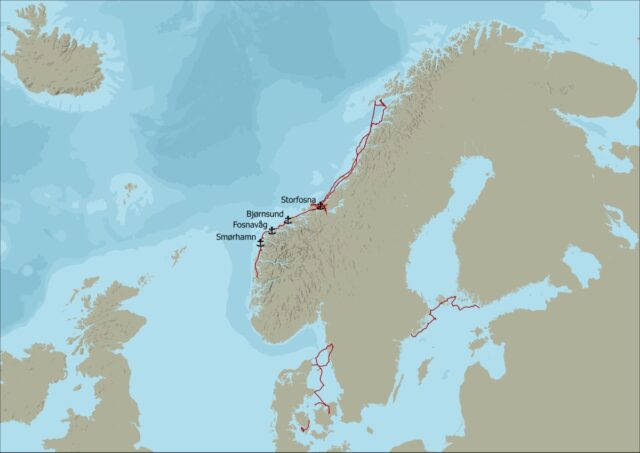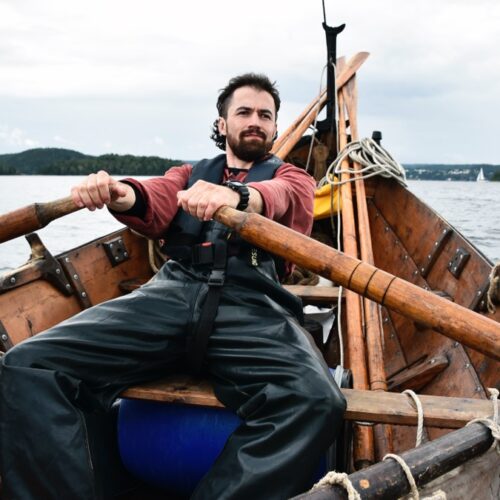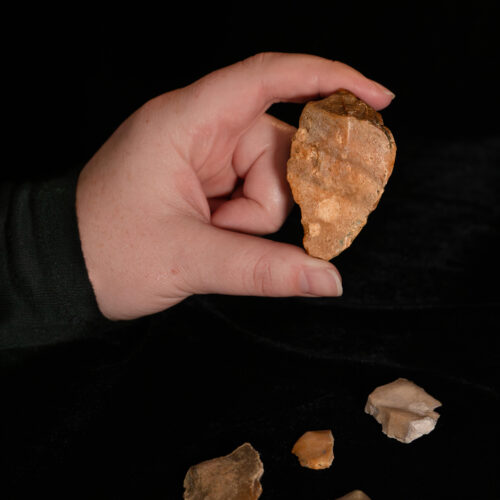“On we sweep with threshing oar”
Greer Jarrett has identified four possible small ports, or “havens,” used by Vikings along the Norwegian coast.
Experimental archaeologist Greer Jarrett of Lund University in Sweden has been sailing in the footsteps of Vikings for the last three years.
If you want to learn more about how and where the Vikings sailed, making the journey through the fjords yourself in replica boats is a practical, hands-on approach to achieving that end. Greer Jarrett, an archaeologist at Lund University in Sweden, has spent the last three years doing just that, sailing more than 5,000 kilometers along known Viking trade routes in open, spare-rigged clinker boats similar to those used by the Vikings.
Not only has Jarrett learned a great deal about the boats themselves, he also identified four possible havens along the Norwegian coast, part of what may have been a decentralized network that played a crucial role in trade and travel during that period. And those ports are located farther out to sea than other major ports and hubs known to date, according to a paper he published in the Journal of Archaeological Method and Theory.
It’s just the latest intriguing discovery enabled by the growing field of experimental archaeology, whereby researchers seek to reverse-engineer all manner of ancient technologies. Experimental archaeologists have, for instance, built their own versions of Early Upper Paleolithic adzes, axes, and chisels. The resulting fractures and wear enabled them to develop new criteria for identifying the likely functions of ancient tools. Others have tried to cook like the Neanderthals, concluding that flint flakes were surprisingly effective for butchering birds, and that roasting the birds damages the bones to such an extent that it’s unlikely they would be preserved in the archaeological record.
Kent State University’s Metin Eren has done practical experiments to study, for instance, the trajectories of atlatls attached to spears tipped with replica Clovis points, and how their performance compares to javelins used by Neanderthals. He even fashioned rudimentary blades out of his own frozen feces to test whether they could cut through pig hide, muscle, and tendon—solely to test a famous anthropological legend about an elderly Inuit man in the 1950s who purportedly did the same to kill and skin a dog, using its rib cage as a makeshift sled to venture off into the Arctic. (It did not work, so myth: busted. But it did snag Eren an Ig Nobel prize.)
Taking a hands-on, experimental archaeological approach to studying the Vikings makes sense in light of the dearth of contemporary written sources. “We have a few things written by outsiders, but there’s very, very few accounts written or delivered by people from Scandinavia during that period,” Jarrett told Ars. “We normally rely on indirect forms of evidence, be that genetics or archaeology or linguistics, which show strong, very frequent connections across maritime areas in the North Atlantic. But because traveling by boat is kind of an archaeologically invisible act, you don’t leave any footprints. So we have very little information about the voyages between these points.”

The sailing voyages made by Greer Jarrett during the research project, as well as the four possible Viking harbors he identified. Credit: Greer Jarrett
Garrett and his crew used four or five different replica boats for their test voyages. Most were built by volunteers, enthusiasts, or students Jarrett had met during his considerable time in the field. They then sailed along the west coast of the Scandinavian Peninsula, a core area of Viking seafaring.
“These are reconstructions of traditional Norwegian boats from the 1800s and early 1900s,” said Jarrett. “My idea was, because of this really long-term continuity in traditional boat building practices, especially in Norway, it might be possible to use these later boats which have lots of similarities to try and work out the potentials of where people might have gotten out. It’s the idea of suggesting potentials based on practical experience to try and join those dots between the different evidence we have across the Viking world.”
That decision has led to some criticism from colleagues because of the enormous gap in time, but Jarrett defends his choice. “The Viking Age ends in the 11th century, and we’re talking about boats from 800 years later,” he said. “But the construction techniques and the way they are rigged and their general performance characteristics are similar enough. Because this is a project about voyages and not a project about boat building, it seemed like a defensible analogy.”
Seeking safe harbor
“On the long-range voyages, we worked in watches of four hours on and four hours off, and that is just about long enough to get some sleep on your off watch, but also just about short enough that you don’t get really, really, really cold, which is obviously a risk,” said Jarrett. “It was manageable, but we looked like penguins. I mean, we’re wearing six layers of wool at any time and sleeping all stacked together for warmth. But other times it’s really nice. The spring and the autumn in Scandinavia, there’s much more likelihood of high-pressure cycles, which means that it’s clearer and sunnier than in the summer itself.”
Nonetheless, there were some rough moments, such as when the mast spar holding up the mainsail snapped, forcing the crew to improvise and lash two oars together to hold the sail so they could continue their journey. It took several days to repair the boat so it could sail again. There was no safety boat following along in case the crew got into trouble, and no engine, although they did have a life raft, which the crew has yet to use.
Based on his sailing trials, Jarrett believes that the Vikings had no need for navigational tools like maps, a compass, or a sextant, relying instead on what he calls “mental maps”—or a “maritime cultural mindscape”—based on sailors’ memories and experiences passed down orally through generations. Those maps might also be informed by the myths linked to well-known coastal landmarks, such as skerries, small islets, or reefs.
“People had been moving by boat along the west coast of Scandinavia for a really, really, really long time, probably since the late Neolithic, if not earlier—thousands of years before the Viking age,” said Jarrett. “There are big trading networks in place beforehand, and that is reflected in the names, place names along the west coast. My primary argument is if you spend 3,000 years traveling up and down a coastline in which you can use the coast at all times for navigation, then it’s unnecessary to develop instrumentation.”
“Instruments are used when you are in a place out in the open sea that you don’t know,” Jarrett continued. “We definitely know they didn’t have compasses because those don’t arrive from China until the 1200s. There are these ideas about sunstones and sundials, or little sun compasses, which are entirely possible. But there’s no legitimate proof of either of them archaeologically yet. I may well be proved wrong if we find them at some point, but I don’t think they’re necessary for this at all.”
Based on the sailing trials, archaeological and documentary evidence of Viking Age maritime centers, and digital reconstructions of past sea levels. Jarrett was able develop a useful set of criteria for evaluating potential havens. For instance, the site should be reachable in low visibility, with land or sea marks that sailors could use as bearings; large enough to accommodate multiple vessels of at least the size of a fyring (which can house a crew of four to 10 people); provide good protection from sea swell and storm surges; and have access to fresh water, among other criteria. Four sites scored sufficiently high by those criteria to qualify as possible Viking havens.
The four sites are Smørhamn, located at the confluence of Oldersund and the Frøysjø, where an inn and trading post are known to have existed since at least the late 17th century; the archipelago of Sørøyane between Stad and Ålesund, near where the sea battle of Hjörungavágr was fought circa 986 CE; Bjørnsund, a number of small islands off the southwestern tip of Hustadvika; and the island of Storfosna, which appears on 16th and 17th century charts.
“I’m not saying, ‘This is where they went,'” said Jarrett. “I’m saying that, with these kinds of boats under these conditions, it would be possible to go to these places. And it’s much more difficult—not impossible, but much more difficult—to go to these other places or to sail in these other conditions.”
Pining for the fjords
The next step is for Jarrett and other archaeologists to hunt for evidence in support of his hypothesis. “Most of these sites have never been excavated,” said Jarrett. “There’s been a long assumption that these are landing places with the idea that you are dragging your boat ashore. I’m very opposed to that idea because these are two-and-a-half-ton boats, let alone the cargo. Unless you have a team of oxen and 20 people at your command, there is no way you’re getting them on the beach. I’m very convinced that these places have jetties and mooring posts likely preserved underwater. All of that organic material survives much better underwater than it does on land. So I think that’s very possible.”
They might also find smaller items suggestive of a thriving harbor community. “Whenever you go into land, you’ve got something that’s broken, so you need to do repairs,” said Jarrett. “So things like clink nails or piles of balustones or signs of smithing—the typical kind of things you’d use for repairing your ship, I think are possible to find.” Jarrett’s methodology might also prove useful for studying other seafaring communities.
The practical experience of sailing the same seas as the Vikings naturally led to some surprising insights. “You are able to ask very different questions the minute you walk away from your desk and get on a boat,” said Jarrett. “I think it’s essential to do that because you think in new ways. In terms of the results themselves, the boats are extremely seaworthy crafts. When you get in them for the first time, you don’t think that, because they’re very, very light. They feel very flimsy, and they’re very low in the water compared to a modern sailing boat. So you feel really in touch with the wave, which is kind of scary. But because they’re so flexible and because of the way they’re rigged, they’re actually really stable, even in big waves.”
“We kept going out thinking, ‘Oh, this is maybe the limit of what this boat can tolerate,’ and then it would be fine, and we’d be, ‘Okay, let’s go a little bit in slightly bigger waves with slightly stronger wind,'” Jarrett continued. “So I think our comfort zones definitely visibly expanded during that period. And I had the chance to work with the same crews over three years. By the end of those three years, we were doing stuff that we would never have been able to do at the beginning.”
Another big difference from modern boats, Jarrett discovered, is that one cannot sail a traditional Viking craft alone. “It has to be a collaborative effort because of how you need a person at the front and the back of the boat basically at all times,” he said. “So developing the crew together and gaining not only skills, but also trust between us meant that we could do things in 2024 that seemed completely insane just a couple of years earlier. I cannot imagine what that is like if you have an entire lifetime of Viking sailors working together for 30 years. It must be an incredible way of creating social bonds.”
DOI: Journal of Archaeological Method and Theory, 2025. 10.1007/s10816-025-09708-6 (About DOIs).
Jennifer is a senior writer at Ars Technica with a particular focus on where science meets culture, covering everything from physics and related interdisciplinary topics to her favorite films and TV series. Jennifer lives in Baltimore with her spouse, physicist Sean M. Carroll, and their two cats, Ariel and Caliban.






